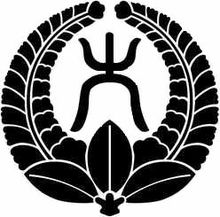- Ōkubo clan
-
In this Japanese name, the family name is "Ōkubo".
The Ōkubo clan (大久保氏 Ōkubo-shi) were a samurai kin group which rose to prominence in the Sengoku period and the Edo period.[1]
In the Edo period, the Ōkubo were identified as one of the fudai or insider daimyō clans which were hereditary vassels or allies of the Tokugawa clan,[2] in contrast with the tozama or outsider clans.
Contents
Ōkubo clan genealogy
The fudai Ōkubo clan traces its origins to 16th century Mikawa province.[2] They claim descent from the Utsunomiya, the descendants of Fujiwara no Michikane (955–995).[3]
- The Ōkubo had taken part in all the military campaigns of Tokugawa Ieyasu, and in 1590 the clan was formally recognized.[2] The Ōkubo were established in the han at Odawara (45,000 koku) in Sagami province. Further, the Ōkubo were charged with defending Odawara castle.[4]
- Ōkubo Tadayo (1531–1593) had taken part in all the military campaigns of Tokugawa Ieyasu; and the main branch of Ōkubo clan consists of his family and their descendants.[3]
- Ōkubo Tadachika (1553–1628) succeeded his father at Odawara, and the revenues of the han had increased to 70,000 koku. In 1614 Tadachika was accused of participation in the plot of Tokugawa Tadateru against his brother, Shogun Tokugawa Hidetada; and the Ōkubo were dispossessed. Tadahicka was confined at Hikone in Ōmi province.[3]
- Ōkubo Tadamoto (1604–1670) was implicated initially in the disgrace of his grandfather; however, he was installed in 1632 at Kanō Domain (50,000 koku) in Mino province, and then he was transferred in 1639 to Akashi Domain in Harima province. He was transferred again in 1649 to Karatsu Domain (90,000 koku) in Hizen province, and he was moved again in 1678 to Sakura Domain in Shimōsa Province. This senior branch of the Ōkubo was restored to Odawara Domain (100,000 koku) in Sagami province, and they have resided at Odawara from 1686 through 1868. The head of this clan line was ennobled as a "Viscount" in the Meiji period.[3]
- A cadet branch of the Ōkubo was created in 1684. This clan line was established for the descendants of Okuba Tadatame (1554–1616), who was the sixth son of Ōkubo Tadakazu. From 1725 though 1868, this branch of the clan resided at Karasuyama Domain (30,000 koku) in Shimotsuke province. The head of this clan line was ennobled as a "Viscount" in the Meiji period.[3]
- A cadet branch of the Ōkubo was created in 1706. This clan line was instituted for the descendants of Ōkubo Norihiro (1657–1737), who were installed at Ogino Domain (13,000 koku) in Sagami province from 1718 through 1868. The head of this clan line was ennobled as a "Viscount" in the Meiji period.[3]
- A cadet branch was created, and this clan line would have been developed from the descendants of Okuba Tadasuke (1537–1613), who was the second son of Ōkubo Tadakazu. Tadasuke had been given Numazu Castle (20,000 koku) in Suruga province; however, he died prematurely without leaving any heirs, and the domain was restored to the shogunate.[3]
- A cadet branch was created for the Ōkubo at Kagoshima in Satsuma province. This clan line was ennobled after the Meiji Restoration. The head of this clan line was ennobled as a "Viscount" in the Meiji period.[3]
- A cadet branch was created for the Ōkubo at Shizuoka in Suruga province; and this clan line was also ennobled after the Restoration. The head of this clan line was ennobled as a "Viscount" in the Meiji period.[3]
Notable clan members
- Ōkubo Tadayo, 1531–1593
- Ōkubo Nagayasu, 1545–1613
- Ōkubo Tadachika, 1553–1628
- Ōkubo Tadataka, 1560–1639
- Ōkubo Tadamoto, 1604–1670
- Ōkubo Norihiro, 1657–1737
- Ōkubo Tadasuke, 1537–1613
- Ōkubo Tadatame, 1554–1616
- Ōkubo Tadazane, 1815-1818—37th Kyoto shoshidai;[1] Rōjū.[5]
- Ōkubo Toshimichi, 1830-1878—1st Finance Minister & 1st Home Minister of Meiji's government.[6] Genrō.[7]
Notes
- ^ a b Meyer, Eva-Maria. "Gouverneure von Kyôto in der Edo-Zeit." Universität Tübingen (in German)
- ^ a b c Appert, Georges. (1888). Ancien Japon, p. 75
- ^ a b c d e f g h i Papinot, Jacques. (2003). Nobiliare du Japon -- Ōkubo, p. 46; Papinot, Jacques Edmond Joseph. (1906). Dictionnaire d’histoire et de géographie du Japon. (in French/German)
- ^ Odawara castle
- ^ Hotoku Ninomiya Jinja Shrine web page
- ^ Röhl, William. (2005). History of Law in Japan Since 1868, p. 98; Acton, John et al. (1906). The Cambridge Modern History, p. 865. London: Macmillan & Company
- ^ McLaren, Walter. (1966). A Political History of Japan: During the Meiji Era, 1867-1912, p. 117
See also
- Satomi Tadayoshi, d. 1622
- Ninomiya Sontoku, 1787–1856
- Yoarashi Okinu, 1845–1872
References
- Acton, John Emerich Edward, George Walter Prothero and Adolphus William Ward and Stanley Mordaunt Leathes. (1906). The Cambridge Modern History, p. 865. London: Macmillan & Company
- Appert, Georges and H. Kinoshita. (1888). Ancien Japon. Tokyo: Imprimerie Kokubunsha
- McLaren, Walter. (1966). A Political History of Japan: During the Meiji Era, 1867-1912.. London: Routledge. 10-ISBN 0-714-62018-1
- Meyer, Eva-Maria. (1999). Japans Kaiserhof in de Edo-Zeit: Unter besonderer Berücksichtigung der Jahre 1846 bis 1867. Münster: Tagenbuch. ISBN 3-8258-3939-7
- Papinot, Jacques Edmund Joseph. (1906) Dictionnaire d'histoire et de géographie du japon. Tokyo: Librarie Sansaisha...Click link for digitized 1906 Nobiliaire du japon (2003)
- Röhl, William. (2005). History of Law in Japan Since 1868. Leiden: Brill Publishers. 10-ISBN 9-004-08591-2
- Sasaki, Suguru. (2002). Boshin sensō: haisha no Meiji ishin. Tokyo: Chūōkōron-shinsha
External links
- (Japanese) "Ōkubo-shi" on Harimaya.com (23 Feb. 2008)
Categories: - The Ōkubo had taken part in all the military campaigns of Tokugawa Ieyasu, and in 1590 the clan was formally recognized.[2] The Ōkubo were established in the han at Odawara (45,000 koku) in Sagami province. Further, the Ōkubo were charged with defending Odawara castle.[4]
Wikimedia Foundation. 2010.

